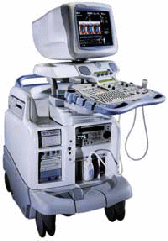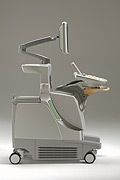Medical Ultrasound Imaging
Monday, 13 May 2024
'Cine' p9 Searchterm 'Cine' found in 44 articles 3 terms [ • ] - 41 definitions [• ] Result Pages : •
The main advantage of ultrasound is that certain structures can be observed without using radiation. However, ultrasound is energy and there are ultrasound safety regulations, because two bioeffects of ultrasound are heat and cavitation. Ultrasound is a mechanical energy in which a pressure wave travels through tissue. Reflection and scattering back to the transducer are used to form the image. As sound energy is transmitted through the tissue, some energy is reflected and some power is absorbed. Possible physical effects with ultrasound:
•
Thermal effects of ultrasound, because tissues or water absorb the ultrasound energy with increase in temperature.
•
Cavitation is the formation, growth, and dynamic behavior of gas bubbles (e.g. microbubbles used as contrast agents) at high negative pressure. This dissolved gases come out of solution due to local heat caused by sound energy. This has been determined harmful at the level of the medical usage.
•
Mechanical effects of ultrasound include ultrasound radiation force and acoustic streaming.
The ultrasound safety is based on two indices, the mechanical index (MI) and the thermal index (TI). The WFUMB guidelines state that ultrasound that produces temperature rises of less than 1.5°C may be used without reservation. They also state that ultrasonic exposure causing temperature rises of greater than 4°C for over 5 min should be considered potentially hazardous. This leaves a wide range of temperature increases which are within the capability of diagnostic ultrasound equipment to produce and for which no time limits are recommended. However, it has not been determined that medical ultrasound causes any adverse reaction or deleterious effect. The American Institute of Ultrasound in Medicine states that as of 1982, no independently confirmed significant biologic effects had been observed in mammalian tissue below (medical usage) 100mW/cm2. See also Ultrasound Regulations and Ultrasound Radiation Force. •
Conventional, CT and MR imaging technologies are limited in their availability, to depict soft tissue, or to show dynamic activity, like cardiac muscle contractility and blood flow. Easy applicability, real-time sonography and biopsy facilitation are important advantages in veterinarian medicine. Veterinary ultrasound has a very high sensitivity to show the composition of soft tissues, but the low specificity is a disadvantage. High ultrasound system performance includes Doppler techniques, contrast enhanced ultrasound, 3D ultrasound, and tissue harmonic imaging to improve resolution. Technical and physical requirements of veterinary ultrasound are the same as in human ultrasonography. The higher the sound frequency, the better the possible resolution, but the poorer the tissue penetration. Image quality is depended of the ultrasound equipment. For example, a 10 MHz transducer is excellent for imaging of superficial structures; a 3.5 or 5.0 megahertz transducer allows sufficient penetration to see inner structures like the liver or the heart. In addition, the preparation and performing of the examination is similar to that of humans. The sound beam penetrates soft tissue and fat well, but gas and bone impede the ultrasonic power. Fluid filled organs like the bladder are often used as an acoustic window, and an ultrasound gel is used to conduct the sound beam. •  From GE Healthcare.;
From GE Healthcare.;'Vivid 7 Dimension, a premier cardiovascular ultrasound system from GE Healthcare, expands on the strength of a powerful imaging platform to offer new, innovative technology of dimensional proportions.'
Device Information and Specification
CONFIGURATION
Multi-frequency, linear, convex, phased, sector
B-mode, C-mode, M-mode (and 2-D), triplex mode, harmonic imaging, color flow mapping, 3D ultrasound display, power Doppler imaging (PDI), color Doppler, pulsed wave Doppler, continuous wave Doppler, tissue velocity imaging (TVI), tissue type imaging (TTI), strain rate imaging (SRI), tissue synchronization imaging (TSI)
IMAGING OPTIONS
CINE review with 5 speed types, bi- andtri-plane imaging with e.g. stress echo and tissue synchronization imaging
STORAGE, CONNECTIVITY, OS
Patient and image archive, HDD, MOD, DVD, USB flash card, DICOM 3.0 Windows-based
DATA PROCESSING
Digital beamformer with 1024 system processing channel technology
H*W*D m (inch.)
1.58 * 0.64 * 0.89 (62 * 25 * 35)
WEIGHT
191 kg (420 lbs.)
POWER CONSUMPTION
less than 2 KVA
•  From Philips Medical Systems;
From Philips Medical Systems;'The Philips iU22 system combines Intelligent Design, including breakthroughs in ergonomics, with Intelligent Control, providing new levels of automation, to give you revolutionary performance and workflow.'
Device Information and Specification
APPLICATIONS
Abdominal, cardiac (also for adults with TEE), musculoskeletal (also pediatric), OB/GYN, prostate, smallparts, transcranial, vascular
CONFIGURATION
17' high resolution non-interlaced flat CRT, 4 active probe ports
B-mode, M-mode, coded harmonic imaging, color flow mode (CFM), power Doppler imaging (PDI), color Doppler, pulsed wave Doppler, tissue harmonic imaging
IMAGING OPTIONS
CrossXBeam spatial compounding, coded ultrasound acquisition),speckle reduction imaging (SRI), TruScan technology store raw data, CINE review with 4 speed types
OPTIONAL PACKAGE
Transesophageal scanning, stress echo, tissue velocity imaging (TVI), tissue velocity Doppler (TVD), contrast harmonic imaging
STORAGE, CONNECTIVITY, OS
Patient and image archive, HDD, DICOM 3.0, CD/DVD, MOD, Windows-based
DATA PROCESSING
Digital beamformer with 1024 system processing channel technology
H*W*D m (inch.)
1.62 * 0.61 * 0.99 (64 * 22 * 43)
WEIGHT
kg (345 lbs.)
POWER CONSUMPTION
Result Pages : |
Medical-Ultrasound-Imaging.com
former US-TIP.com
Member of SoftWays' Medical Imaging Group - MR-TIP • Radiology TIP • Medical-Ultrasound-Imaging
Copyright © 2008 - 2024 SoftWays. All rights reserved.
Terms of Use | Privacy Policy | Advertise With Us
former US-TIP.com
Member of SoftWays' Medical Imaging Group - MR-TIP • Radiology TIP • Medical-Ultrasound-Imaging
Copyright © 2008 - 2024 SoftWays. All rights reserved.
Terms of Use | Privacy Policy | Advertise With Us
[last update: 2023-11-06 01:42:00]




